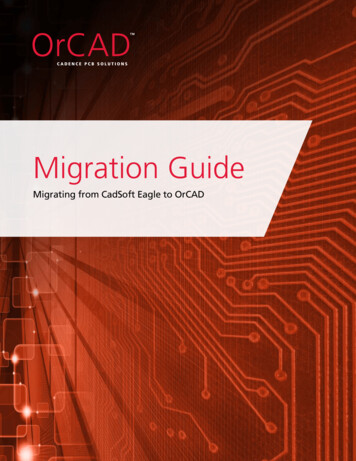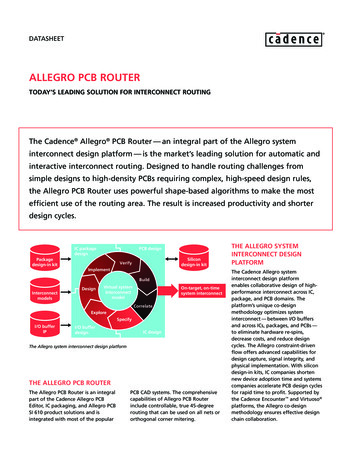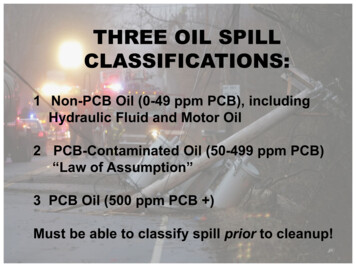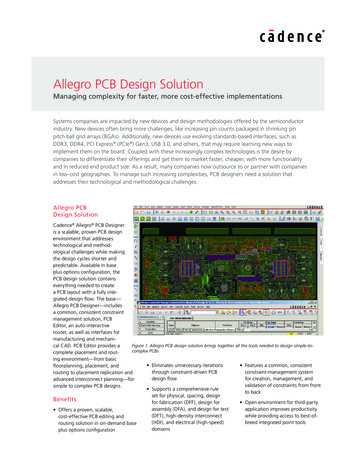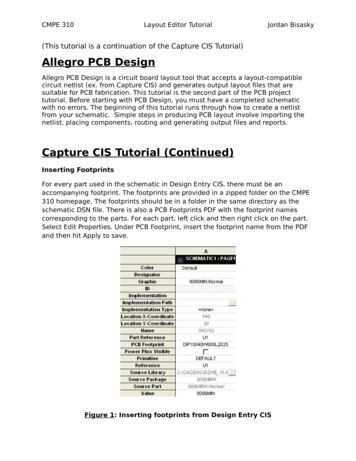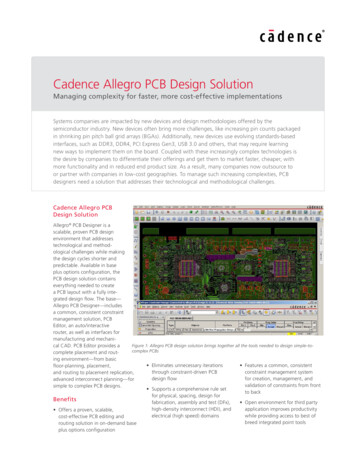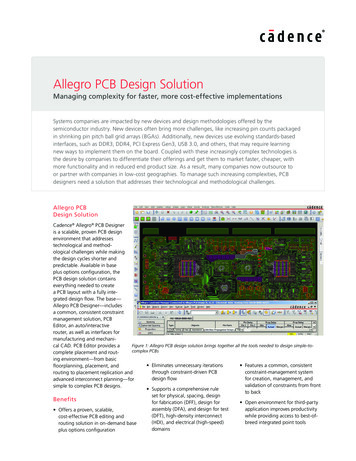
Transcription
Flexible PCB Antenna with CableIntegration Application NoteVersion .BASICSAPPLICATIONSSIZESHAPEGROUND PLANE ONTECHNOLOGY ADVANTAGESMOUNTINGENVIRONMENTAL CONSIDERATIONSTUNINGISOLATIONCABLE & CONNECTOR All Rights ReservedTaoglas Limited, Unit 3 Enniscorthy Technology Centre, Enniscorthy, Co. Wexford, Irelandwww.taoglas.com
1.BASICSA Flexible PCB antenna with cable is a very flexible, low profile, highly reliableand economical solution widely used in the wireless industry.Usually consisting of polyimide flexible PCB (polyimide), a trace is printed on thesubstrate to get the desired antenna topology. Various antenna types such asmonopoles, dipoles and printed F antennas can be made.This design application note is intended to help the antenna integratorunderstand the relevant parameters affecting the antenna performance. Taoglasrecommends that the integrator strictly follow the guidelines in this applicationnote, upon your device prototype completion Taoglas can provide furtheroptimization by custom tuning and testing service of the antenna in your device.(see Note 15 on Page 6 for further info on Tuning)2.APPLICATIONSA Flexible PCB antenna with cable is suitable for mobile applications or areaswhere internal antennas are required or where not much space or volume isavailable. It is ideally affixed to the plastic housing of a device directly by doublesided adhesive. Taoglas Flexible PCB antennas come in single-band or multiband solutions. Starting from 450MHz up to 6 GHz.3.SIZEThe larger the antenna surface area (or volume), in general the higher theperformance in terms of gain and radiation characteristics. All Rights ReservedTaoglas Limited, Unit 3 Enniscorthy Technology Centre, Enniscorthy, Co. Wexford, Irelandwww.taoglas.com
4.SHAPE AND THICKNESSA Flexible antenna can be made into any 2D shape for ease of fit into a product.Flexible PCB antennas are super low profile 0.5mm5.GROUND PLANE EFFECTSDipole antennas can be classed as being largely ground-plane independent interms of performance. Planar antennas such as F-Type interact with the groundplane more. In general we wish for 20mm clearance from the main ground-planefor reasons of efficiency.6.IMPEDANCERF circuits in mobile devices should be designed for a 50 Ohm characteristicimpedance at the source (RF module), transmission line (PCB trace or coaxcable) and load (antenna). In practice sometimes the characteristic impedance ofthe circuit is not 50 Ohms at different transmitting and receiving bands. Thisnecessitates the antenna impedance to be changed to match the actualcharacteristic impedance of the circuit. For a cellular antenna this is mosteffective when tuning the antenna at over the air active testing stage when thedevice is turned on and using the TRP and TIS numbers as guide to find the bestimpedance match for the antenna.7.BANDWIDTHBandwidth is defined as the frequency band below -10dB return loss.Taoglas PCB antennas in general are rated at a minimum of -7.5dB return lossfor the targeted application bands (for example GSM 850/900/1800/1900). Areturn loss of below -10dB is targeted for the centre of the bands. -5dB returnloss at edge of bands where it rolls off.8.VSWRIn principle the target is to be below 2.0, ideally below 1.5. In practice in multiband and challenging environments it may go to 3.0. All Rights ReservedTaoglas Limited, Unit 3 Enniscorthy Technology Centre, Enniscorthy, Co. Wexford, Irelandwww.taoglas.com
9.GAINThe gain of the antenna is closely linked to the surface area or volume of theantenna. The larger the surface area or volume of the antenna, the higher thegain. Care must be taken that clearances of minimum 4mm are kept from othermetal components in the device or metallised substances which will absorb orreflect the electro-magnetic radiation, substantially reducing the gain. The largerthe clearance, the better the radiation characteristics of the antenna. Werecommend 20mm or more for best gain and radiation efficiency.10. EFFICIENCYEfficiency is a good overall measurement of an omni-directional antenna formobile communication systems such as GSM and WLAN. A PCB antenna canbe designed to have high efficiency ( 30% to 50% ) if the antenna surface areais large enough. It is more difficult to achieve high efficiency for more than twobands or in very compact form factor housings. Efficiency of the antenna directlyrelates to the TRP/TIS results of a device in OTA testing if the module has 50Ohm impedance.11. POLARIZATIONPolarization describes the orientation of the wave oscillation. All our cellular andbroadband antennas are linearly polarized to most efficiently match with thesignals broadcast and the antennas mounted on cellular base-stations and fromhot-spots Whether it is horizontally or vertically polarized depends just dependson how it is mounted from your frame of reference. Standing directly in front ofthe antenna the linear polarization is horizontal if the antenna is placed in ahorizontal position and vertical if the antennas are placed in a vertical position. Inpractice the radiation emitted and received by internal antennas will be to somedegree cross-polarized due to reflections from the environment and scattering inthe atmosphere. All Rights ReservedTaoglas Limited, Unit 3 Enniscorthy Technology Centre, Enniscorthy, Co. Wexford, Irelandwww.taoglas.com
12. ADVANTAGES of Flexible antennas with cableooooAdheres directly to inner shell of plastic housing of deviceNo space needed on main-board of deviceExtremely low profileDesign Flexibility – size, shape, cable, connector all fully customizablewith minimum tooling costo Quick turn-around time on new designs – 2 weeks to prototypeso Multi-band frequencies easily accommodatedo Economical pricing13. MOUNTINGTaoglas flexible PCB antennas use 3M 467 double-sided adhesive for the mostreliable mounting solution. Ideally the Flexible PCB antenna is mounted close tothe outer housing of the device to allow it to radiate outwards and receive signalswithout obstruction from internal components in the device. The antenna can beslid into a slot, screwed down, or affixed with double-sided adhesive. Cable exitcan be moved to different locations on the antenna. Generally the orientation ofthe antenna is not critical, as long as clearance to metal components is kept.14. ENVIRONMENTAL CONSIDERATIONSClose proximity to components or housing affects the electrical performance ofall antennas. When placed on a non-conductive area of the board, in most casesideally there should be clearance of 20mm in all directions from theboard/housing for maximum efficiency. A reduction in the efficiency of theantenna efficiency and shift in tuned frequency will be observed if theseclearances are not adhered to. Proximity effects will also have an adverse effecton the radiation pattern of the antenna. Device housings should never be metalor have metal materials15. TUNINGThe frequencies of Flexible PCB antennas with cable are easily shifted whenclose to other components or even if the cable is bent more than 30 degrees.This phenomenon is called “detuning”. We offer Flexible PCB antenna samplesto customers on the understanding that they be tested outside the device as abenchmark performance. The actual production antenna will be customized foreach customer.This is why Taoglas always offers a tuning service to it’s customers at prototypeintegration phase. We “tune” the antenna frequency back to the right bands forthe application at our lab. Samples are sent back to the customer within 2 weeksof receiving the device along with a test report showing antenna performance All Rights ReservedTaoglas Limited, Unit 3 Enniscorthy Technology Centre, Enniscorthy, Co. Wexford, Irelandwww.taoglas.com
Return Loss/VSWR, Gain and Radiation Characteristics, in the customer device.Please contact us for costing for this service. sales@taoglas.comFurther services such as optimizing the RF performance of the whole device toenable the product to pass network approvals, regulatory compliance or specificperformance targets are offered as well.16. ISOLATIONIsolation is a measure of coupling between two different antennas. For examplein a CDMA diversity antenna plan the target is to get -10dB isolation between themain and the auxiliary antenna. Greater isolation can be achieved by usingdifferent polarizations on the two antennas. For example the main antenna hashorizontal linear polarization and the auxiliary antenna has vertical linearpolarization. In practice this is difficult for Omni-directional internal cellularantennas as there is cross-polarization of the waves occurring. So the normalsolution is to keep the distance from both antennas as far away as possible.The two antennas cables should not cross over or come close to the other’santenna.Testing is carried by sending a signal in one antenna and measuring the powerof the signal at the other antenna. There should be a 10dB or more differencebetween the transmit and the receive signal. The easiest method is to keepmoving the two antennas farther from each other until the target isolation isachieved.17. CABLE & CONNECTORØ1.13mm diameter micro coax cable is preferred in most cellular antennaprojects as most economical solution. Cable loss is not a big factor if cable lengthis kept below 150mm.The cable needs good grounding. If the body of the cable is near the ground ofthe device the cable should be as near as possible to the device ground.The cable should not be looped because it will cause frequency shifts and alsocreate magnetic field which will interact with the main antenna magnetic field.The cable should be kept away from emitting components such as LCD driverchip or CPU. All Rights ReservedTaoglas Limited, Unit 3 Enniscorthy Technology Centre, Enniscorthy, Co. Wexford, Irelandwww.taoglas.com
t is preferred to use connectors on the cables for higher reliability in connectionover solder. Most economical connector solution is IPEX line of connectors whichis compatible with Hirose industry standards U.FL and W.FL. Taoglas offers anycable and connector solution for the integrator. Taoglas also offers the on-boardmating connector and cable jumpers. All Rights ReservedTaoglas Limited, Unit 3 Enniscorthy Technology Centre, Enniscorthy, Co. Wexford, Irelandwww.taoglas.com
Taoglas Limited, Unit 3 Enniscorthy Technology Centre, Enniscorthy, Co. Wexford, Ireland www.taoglas.com 1. BASICS A Flexible PCB antenna with cable is a very flexible, low profile, highly reliable and economical solution widely used in the wireless industry. Usually consisting of polyimide flexible PCB (polyimide), a trace is printed on the
